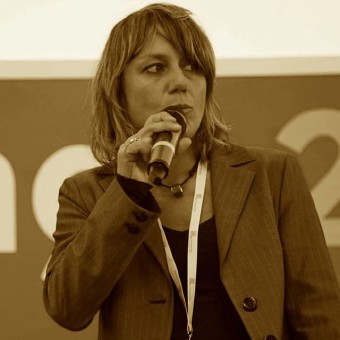Voices of the stakeholders
Interview with Prof. Ing Adriana Del Borghi

The Circular Economy aims to redefine products and services to design waste out, while minimizing negative impacts.
In this interview with Prof. Ing Adriana Del Borghi, the key concepts of circular model, building economic, natural and social capital,embedded in the AMiCE Project are discussed.
Professor Del Borghi, please tell us about the circular economy model and principles
The circular economy is a model of production and consumption departing from the traditional, linear economic model which was based on a take-make-consume-throw away pattern and relied on large quantities of cheap, easily accessible materials and energy. The circular economy involves sharing, leasing,reusing, repairing, refurbishing and recycling existing materials and products extending the life cycle of products and reducing waste to minimum. When a product reaches the end of its life, its materials are kept within the economy wherever possible. These can be productively used again and again, thereby creating further value.
What are some of the challenges that business and innovation could face in implementing a switch to the closed loop economy model?
The concept of circular economy provides inspiration for businesses to increase their resource efficiency providing new insights and thereby stimulate innovation.
Circular economy principles that can inspire business reducing environmental impacts as well include: lightening,reducing the amount of materials needed to provide a certain service;durability,extending the useful life of the products; efficiency,reducing energy and material consumption in the production and use phases; replacement,reducing the use of dangerous or difficult to recycle materials in products and production processes; recycled materials,creating markets for secondary raw materials; eco-design,designing products that are easy to keep in good condition, to repair, modernize, re-manufacture or recycle; industrial symbiosis,favoring the grouping of activities to prevent by-products from becoming waste; and sharing economy,encouraging consumers to move towards rental, loan or sharing services instead of purchasing.
How additive manufacturing can be part of circular economy principles
Circular economy is not only a global economic model that decouples economic growth from the consumption of finite resources, but it focuses on effective design and use of materials to optimise their flow and provides new opportunities for innovation across fields such as product design and new business models.
Additive manufacturing, also known as 3D printing, is acknowledged for its potential to support eco design. In the context of circularity, the opportunities that additive manufacturing offers include the support of circular design strategies by creating opportunities to extend a product's lifespan, by enabling repair or upgrades, even if these products were not originally designed for ease of repair or upgrading thus increasing the lifespan of products.
Additive manufacturing re-engages people with product development, manufacture and life cycle. A product designed on one side of the world can be printed out on the other side of the world without delivering products and components. Furthermore, design for self-assembly and design for disassembly - one of the key principles of Circular Economy - become easier than ever: products can be designed for easy and swift assembly with each component easy replaceable.
Moreover,3D printed objects can be lighter due to the possibility of density specification through 3D printing and to the replacement of components such as screws with snap fittings. Finally, 3D printing can be performed using recycled material without any loss of functionality and performance.
How the key concepts of circular model are embedded in the AMiCE Project
In the AMiCE Project, several case studies have been collected presenting valuable opportunities for synergy between additive manufacturing and circular economy principles and goals. Additive manufacturing is considered to be promising for sustainable production because of its additive and digital nature that offers new solutions to save resources and reduce waste, thus increasing the circularity of the whole production and consumption system.
Additive manufacturing supports circular design strategies also by creating opportunities to extend the lifespan of products, e.g. by enabling repair or upgrades, and by allowing better exploitation of recycled materials, e.g. recycled plastic filaments used for 3D-printing. Int his way, it is possible to create and rethink new logics and best practices to re-use materials and products.
Therefore,the project shows how additive manufacturing can provide valuable contributions towards a circular economy, pushing the SMEs to the implementation of CE industrial strategies
